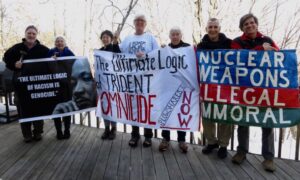Recently the Bulletin of Atomic Scientists met to share their annual Doomsday Clock. The Council decided to keep the Doomsday Clock, which estimates the probability of a nuclear catastrophe at 90 seconds to midnight. That same time was set a year earlier in 2023, the closest the clock has been set to midnight, the deadline representing nuclear annihilation. Some of the factors that have influenced the ‘second hand’ to midnight have been increased threats of nuclear war, climate crisis, and misinformation in our culture especially as it influences our politics.
Founded in 1945 by Albert Einstein, J. Robert Oppenheimer, and University of Chicago scientists who helped develop the first atomic weapons in the Manhattan Project, the Bulletin of the Atomic Scientists created the Doomsday Clock two years later, using the imagery of apocalypse (midnight) and the contemporary idiom of nuclear explosion (countdown to zero) to convey threats to humanity and the planet. The Doomsday Clock is set every year by the Bulletin’s Science and Security Board in consultation with its Board of Sponsors, which includes nine Nobel laureates. The Clock has become a universally recognized indicator of the world’s vulnerability to global catastrophe caused by man-made technologies.

Doomsday clock from WikiMedia Commons
There was a recent article in the New York Times Secret Wrapped in a Secret: A Bombs Funding that inquired about how the Manhattan project was funded amongst such secrecy. Eight decades after the atomic bombs were dropped on Japan, the question of how this weapon that could potentially destroy all life on this planet was funded and what oversight was in place. It turns out that when Congress voted to fund the bomb, there was no debate and no discussion. Only seven lawmakers in the entire Congress had any idea that they were approving $800 million — the equivalent of $13.6 billion today — to create a weapon of mass destruction that would soon kill and maim more than 200,000 people, ushering in the atomic age.
As we have been doing WTR 101 sessions, we often mention how the modern U.S. war tax resistance dates back to the Conscientious Objectors to World War II. The arrival of the atomic age solidified the will of war resisters who refused to pay for war and the preparations for war. One resistor of that era, Ammon Hennacy stated “being a pacifist between wars is like a vegetarian between meals.”

Action at King’s Bay GA with a banner connecting nuclear weapons to omnicide
There is a whole new generation of nuclear weapons being developed at present. Some of the secret locations of the Manhattan Project over 80 years ago continue to Los Alamos, NM, Oak Ridge, TN, Lawrence Livermore, CA and numerous subcontractors throughout the US including Honeywell in Kansas City continue to produce nuclear weapons that contaminate the land, water and creatures that live near these sites. Last month, the Biden administration bypassed Congressional approval for emergency weapons sales for the second time further diminishing the power of the purse that Congress wields in providing oversight to military spending.
A new generation of nuclear weapons is coming online and a whole generation of people are resisting and refusing to pay for our omnicide. There are a couple of campaigns: We the People and War Tax Resistance Collective that are getting the message of resisting paying for preparations for war; redirecting resources to our community needs.
Post by Chrissy Kirchhoefer





A friend of mine just got back from a grueling USO tour of England, Poland, Rooumania, and Germany, and wrote me:
“At the end of the tour, I happened to be sitting next to the admiral who sponsored it. I said, “Where do the young soldiers come from?” He replied with exceptional frankness, “Broken homes. They have no family and that’s what we can offer them here.”
I found that horrifying.
So as you’re thinking about ways to oppose recruitment, I suggest you ask yourself, “What concrete steps could I, Eleanor Forman, take to offer the elements of family and structure to deprived young people who would otherwise seek them in the military” ”
I was once in the Big Brothers/Big Sisters program and found it problematic. What do you all suggest?